Overview
Here is a quick summary of the major differences between the versions in my collection:
[ Top
| Version B
| Version C
| Version D
| Version E
| Version F
| Version G
| Version H
| Version I
| J /w Roller
| Friendship-2
| Return to H.E.C. Ascenders
]
Version A
(#1533)
Technical Details
I acquired my Gear4Rocks, Version A ascender new from the Gear4Rocks eBay store in 2010. Gear4Rocks is the same company as Krok, the only difference is that the Krok trademark sells gear only inside the Ukraine, and the Gear4Rocks trademark was created to spread Ukrainian gear around the world.
Version A is 191 mm. tall, 93 mm. wide, 31 mm. thick, and weigh 204 g.
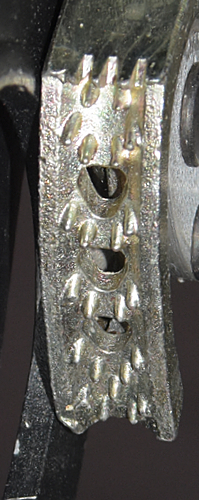 The shell is a tall irregular shaped stamping made from 3.5 mm. aluminum-magnesium alloy sheet metal. The stamping has shallow reinforcing stamped into the front strap, the upper portion of the back strap, and the area behind the cam. A rope channel is formed in the
upper portion of one side and a smaller cam channel lies opposite
the first. The rope channel is 17 mm. wide. A hole drilled through both sides of the cam channel
accepts a 5.5 mm. rivet. The cam and cam spring are mounted
on this rivet.
The handle below the cam has a soft "rubbery" hand grip molded into place. The hand grip has four shallow finger
grooves. A 15 mm. sling attachment hole is punched below
the handle opening, and a 10 mm. hole is punched below and
outside the first. A 13.8 by 18.7 mm. pear-shaped hole through both
sides of the rope channel provides an attachment point just above
the cam. Version A has a stamped cam stop that does not contact the cam.
The shell is a tall irregular shaped stamping made from 3.5 mm. aluminum-magnesium alloy sheet metal. The stamping has shallow reinforcing stamped into the front strap, the upper portion of the back strap, and the area behind the cam. A rope channel is formed in the
upper portion of one side and a smaller cam channel lies opposite
the first. The rope channel is 17 mm. wide. A hole drilled through both sides of the cam channel
accepts a 5.5 mm. rivet. The cam and cam spring are mounted
on this rivet.
The handle below the cam has a soft "rubbery" hand grip molded into place. The hand grip has four shallow finger
grooves. A 15 mm. sling attachment hole is punched below
the handle opening, and a 10 mm. hole is punched below and
outside the first. A 13.8 by 18.7 mm. pear-shaped hole through both
sides of the rope channel provides an attachment point just above
the cam. Version A has a stamped cam stop that does not contact the cam.
The cam is a plated skeletonized steel casting. The cam has
number of small conical teeth, all of which have their axes sloping downward. The cam radius increases from 36 to 58 mm. over an angle of 41°, giving a 34° cam angle. The tooth pattern is (3.2)(2.2.H)^3(2.2.3.2) where "H" indicates a mud relief hole. A spring-loaded manual safety
bar is attached to the side of the cam. There are two pins riveted to the safety. The first, 8 mm. high by 7.3 mm. diameter steel, stops the cam from closing fully against the rope channel (functional on the right-hand ascender only). The second, 11.2 mm. high by 9.7 mm. diameter aluminum, acts as a thumb post. The normal action of
the spring holds the safety against the cam. When the cam is opened,
the shell interferes with the safety bar, thus preventing opening
the cam. If the safety bar is moved away from the cam (opposing
the spring), it will clear the shell and the cam will open. At
full open the safety can be released and the spring will hold
the safety against the back of the shell. This provides a means
of locking the cam open. A pin on the safety assists in operating
the safety mechanism.
There are no markings on these ascenders.
The safety design is similar to the ones on various Climbing Technology ascenders.
The attachment points are simply sharp-edged holes in the shell. Even if they had been rounded,
I would consider their small radius too sharp for directly attaching
sling ropes. I would recommend using a small maillon
for most attachments in order to reduce the risk of sling abrasion.
The lower attachment hole could theoretically have the same safety
problems as the one on Clog Version A.
The upper rope attachment hole is located very close to the main
rope. A carabiner through the upper attachment hole will probably
drag on the main line. Note that such a carabiner will prevent
putting the ascender on or off rope, so one’s climbing system
must be designed accordingly.
The safety is reasonably easy to use with one hand, but the
cam drags on the shell, and since both have a rough
finish, it gives the ascender a gritty feel. This is not a significant
issue.
The
handle roomy,but the the hand grip is too square for my taste. A file
can eliminate this objection.
The cam is poorly made:
the teeth are blunt, there are defects in the casting, and the finish is rough.
This ascender has the same pit lip disadvantage as the Clog and other stamped frame ascenders.
The shell is thicker that the one on the Camp
Pilot, Kong-Bonaiti, and Petzl
Ascension but it isn't reinforced as it is on those.
I'm not sure the extra holes are needed at the base. Except for the Petzl Pompe, I've never found a real need for a second hole. Some people like them, and I might find them more appealing if they were large enough for a standard carabiner to fit through.
[ Top
| Version A
| Version C
| Version D
| Version E
| Version F
| Version G
| Version H
| Version I
| J /w Roller
| Friendship-2
| Return to H.E.C. Ascenders
]
Version B
(#1565)
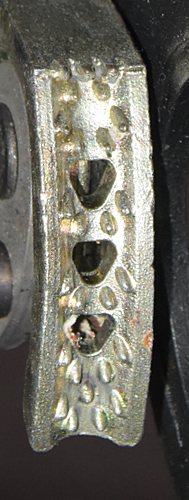 Technical Details
Technical Details
I acquired my Gear4Rocks, Version B ascender new from the Gear4Rocks eBay store in 2010 as part of a pair with Version A.
Version B is 191 mm. tall, 93 mm. wide, 31 mm. thick, and weighs 206 g. The rope channel is 17 mm. wide. The pivot is centered 49 mm. from the inside of the rope channel. The cam radius increases from 36 to 58 mm. over an angle of 41°, giving a 34° cam angle. The tooth pattern is (3.2)(2.2.H)^3(2.2.3.2).
Version B has a 6 mm. tall, 6 mm. diameter post riveted to the shell above the cam. This acts as a cam stop to keep the cam from closing fully. Otherwise, Versions B and A are identical.
Gear4Rocks changed the cam stop in 2010, and the pair I bought had one of each. The newer cam stop contacts the cam.
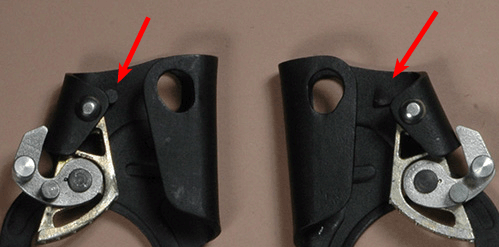
Difference between Version B (left) and Version A (Right)
[ Top
| Version A
| Version B
| Version D
| Version E
| Version F
| Version G
| Version H
| Version I
| J /w Roller
| Friendship-2
| Return to H.E.C. Ascenders
]
Version C
(#2090)
Technical Details
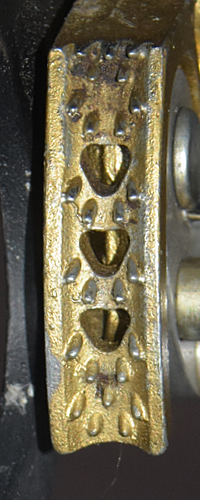 I acquired my Krok, Version C in 2017 as part of Bob Thrun’s collection.
I acquired my Krok, Version C in 2017 as part of Bob Thrun’s collection.
Version C is 193 mm. tall, 92 mm. wide, 31 mm. thick, and weighs 203 g. The rope channel is 17 mm. wide. The pivot is centered 49 mm. from the inside of the rope channel. The cam radius increases from 36 to 58 mm. over an angle of 41°, giving a 34° cam angle. The tooth pattern is (3.2)(2.2.H)^3(2.2.3.2).
Version C does not have a cam stop, and the cam axle was changed to a semi-tubular rivet.
The front of the rope channel on each ascender is stamped with the Krok logo and a book-with-an-"i" icon. The rear is stamped with "02 11" indicating the manufacturing date.
The cam safety on my Version C will not hold the cam open in the hold-open position. The main cam spring is strong enough to pull the cam closed. I'm not sure why, but it appears that loose manufacturing tolerances conspired to defeat the intended design feature.
Cam stops help ascenders in laboratory strength tests, but unless you are incredibly obese or subject your ascenders to abuse that they should never receive (e.g., dropping multi-person rescue loads), a cam stop is of little consequence to the caver underground.
[ Top
| Version A
| Version B
| Version C
| Version E
| Version F
| Version G
| Version H
| Version I
| J /w Roller
| Friendship-2
| Return to H.E.C. Ascenders
]
Version D
(#2089)
Technical Details
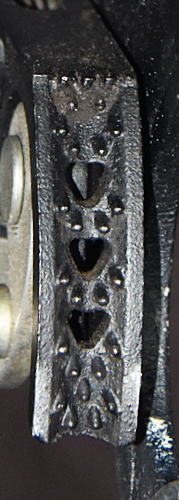 I acquired my Krok, Version D in 2017 as part of Bob Thrun’s collection.
I acquired my Krok, Version D in 2017 as part of Bob Thrun’s collection.
Version D is 193 mm. tall, 92 mm. wide, 31 mm. thick, and weighs 203 g. The rope channel is 17 mm. wide. The pivot is centered 49 mm. from the inside of the rope channel. The cam radius increases from 36 to 58 mm. over an angle of 41°, giving a 34° cam angle. The tooth pattern is (3.2)(2.2.H)^3(2.2.3.2).
Version D introduced a new handgrip design that eliminates most of the finger grooves. The handgrip extends farther toward the front strap than it does on Version C.
The cam on Version D is painted instead of plated.
The front of the rope channel on each ascender is stamped with the Krok logo and a book-with-an-"i" icon. The rear is stamped with "02 11" indicating the manufacturing date.
Reducing the number of finger grooves lets the ascender fit more comfortably in different size hands,
There is little functional difference between Version D and Version C. At least the cam hold-open feature works on my Version D ascender.
[ Top
| Version A
| Version B
| Version C
| Version D
| Version F
| Version G
| Version H
| Version I
| J /w Roller
| Friendship-2
| Return to H.E.C. Ascenders
]
Version E
(#1580, 1581)
Technical Details
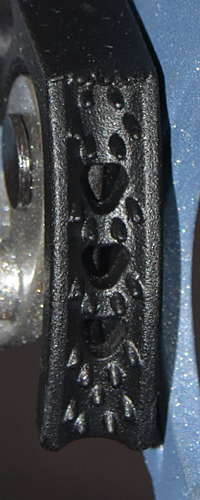 I acquired my Version E from Gear4Rocks in 2012.
I acquired my Version E from Gear4Rocks in 2012.
Version E is 190 mm. tall, 91 mm. wide, 29 mm. thick, and weighs 229 g. The rope channel is 16 mm. wide. The pivot is centered 48 mm. from the inside of the rope channel. The cam radius increases from 37 to 58 mm. over an angle of 41°, giving a 32° cam angle. The tooth pattern is (3.2)(2.2.H)^3(2.2.3.2).
Version E has a steel cam stop like the one on Version B.
The front of the rope channel on each ascender is printed with "0112 No001," the Krok logo, and a book-with-an-"i" icon. They are also stamped with the Krok logo, a book-with-an-"i" icon, and "10 11" indicating the manufacturing date.
I don't notice a practical advantage to cam stops in normal use, but they increase the strength of the ascender in laboratory tests by reducing the likelihood of the cam "pulling through."
[ Top
| Version A
| Version B
| Version C
| Version D
| Version E
| Version G
| Version H
| Version I
| J /w Roller
| Friendship-2
| Return to H.E.C. Ascenders
]
Version F
(3601_1445.2 LH, 3601_1445.1 RH)
(#2996, 2997)
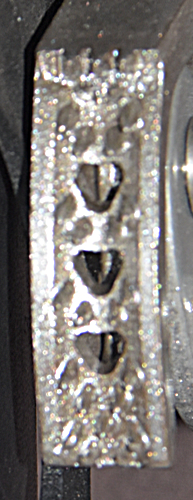 Technical Details
Technical Details
I acquired my Krok, Version F from Krok in 2021.
Version F is 190 mm. tall, 92 mm. wide, 29 mm. thick, and weighs 277 g. The rope channel is 16 mm. wide. The pivot is centered 50 mm. from the inside of the rope channel. The cam radius increases from 37 to 58 mm. over an angle of 42°, giving a 31° cam angle. The tooth pattern is (3.2.2)(1H1.2)^3(2.3.2).
Version F uses a 2 mm. alloy steel frame. It also has a new cam that is covered with a thick paint.
The front of the rope channel on each ascender is printed with "WLL 4kN," a hollow up-pointing arrow with "Max 300 кг" inside,"MBS 20kN," the Krok logo, "1901.1412" on the left and "1901.2116" on the right, and a book-with-an-"i" icon.
The cam metal has changed. I could not find out what it was from Krok’s web site. It may be stainless steel since it is nonmagnetic, and seems to be too hard to be aluminum.
Krok now offers their ascenders in both steel and aluminum versions. The steel handle is stronger and more abrasion resistant than the aluminum-alloy handles.
[ Top
| Version A
| Version B
| Version C
| Version D
| Version E
| Version F
| Version H
| Version I
| J /w Roller
| Friendship-2
| Return to H.E.C. Ascenders
]
Version G
(3601_1445.91 LH, 3601_1445.90 RH)
(#2998, 2999)
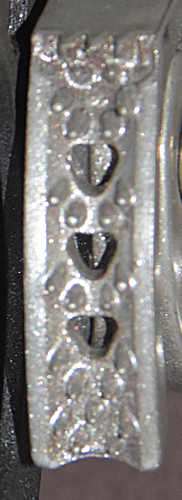 Technical Details
Technical Details
I acquired my Krok, Version G from Krok in 2021.
The Krok, Version G 3601_1445.91 is 190 mm. tall, 91 mm. wide, 30 mm. thick, and weighs 269 g. The rope channel is 16 mm. wide. The pivot is centered 48 mm. from the inside of the rope channel. The cam radius increases from 37 to 58 mm. over an angle of 42°, giving a 31° cam angle. The tooth pattern is (3.2.2)(1H1.2)^3(2.3.2).
The Version G frame has four hexagonal holes 5.5, 7, 8, and 9 mm.) on the back of the ascender and three more (10, 13, and 15 mm.) in the front of the rope channel.
The front of the rope channel is printed with "S15," "S10," and "S10" beneath the corresponding size hexagonal holes. The rear is printed with with "WLL 4kN," a hollow up-pointing arrow with "Max 300 кг" inside, "MBS 20kN," the Krok logo, "1901.14122501 on the left and "1901.2502" on the right, a book-with-an-"i" icon, and "S5.5," "S7," "S8," and "S9" beside the corresponding size hexagonal holes.
While the holes lighten the ascender by about 8 grams, I really don't see much advantage to them. They are not ideally placed to tighten nuts or bolts. I find it more practical to carry a small wrench or multi-tool on normal trips when I don't expect to be tightening fasteners, and to bring a small adjustable wrench when I expect to need one.
[ Top
| Version A
| Version B
| Version C
| Version D
| Version E
| Version F
| Version G
| Version I
| J /w Roller
| Friendship-2
| Return to H.E.C. Ascenders
]
Version H
(36011_51.8 LH)
(#2997)
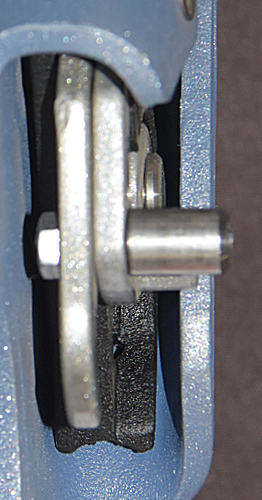
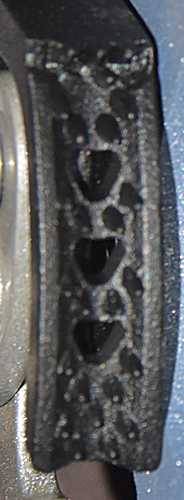 Technical Details
Technical Details
I acquired my Krok, Version H 36011_51.8 from Krok in 2021.
The Krok, Version H 36011_51.8 is 191 mm. tall, 93 mm. wide, 35 mm. thick, and weighs 240 g. The rope channel is 17 mm. wide. The pivot is centered 48 mm. from the inside of the rope channel. The cam radius increases from 37 to 58 mm. over an angle of 42°, giving a 31° cam angle. The tooth pattern is (3.2.2)(1H1.2)^3(2.3.2).
Version H has an aluminum-magnesium alloy frame. Its distinctive feature is the (Рефлекс) trigger attached to the cam safety with a small machine screw.
The front of the rope channel is printed with "WLL 4kN," a hollow up-pointing arrow with "Max 300 кг" inside,"MBS 20kN," the Krok logo, "1809.1101," and a book-with-an-"i" icon.
The reflex trigger is an interesting idea developed by Konstantin Serafimov. Konstantin had read my Rappel Safety post in 2006. His experience matched what my post described and he asked permission to post a Russian translation his web site, which I granted. He then persued developing a way to use ascenders for self-belay while eliminating the "negative action" required to activate the device. Konstantin shared many of his prototype ideas with me in 2014, but we dropped out of touch before he was able to finish developing his ideas. Krok’s documentation of their implementation, as translated by Google, describes its use as follows:
Attention! Do not use clamps as a self-belay. The only exception is “Zhumar” from TM KROK after completing its lock with Serafimov’s “Reflex” trigger, which allows using the user’s panic reflex for instant and trouble-free seizure of the clamp with a working rope (Fig. 14).
When equipping the Zhumar from TM KROK with the Reflex trigger, the zhumar turns from a conventional clamp into a 100% reliable mechanical device for self-belay when descending a rope. Alas. But it is impossible to use this method of self-belay in conjunction with descenders - autolockers controlled by two hands.
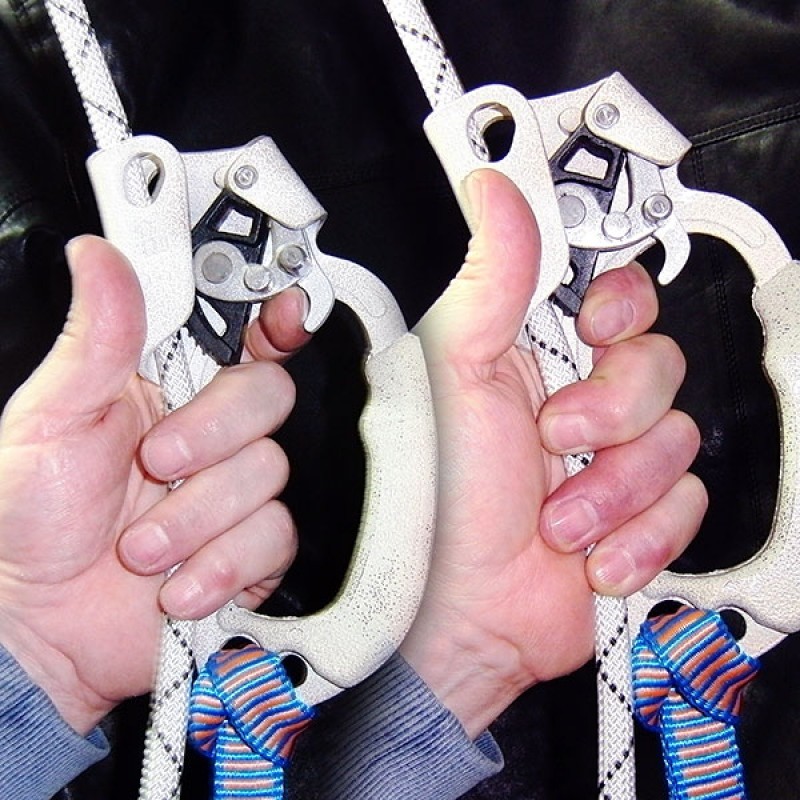 Self-Belay Trigger “Reflex” - the device, when attached to the clamp, allows the user to use the panic reflex to instantly and reliably grasp the clamp with the working rope.
Self-Belay Trigger “Reflex” - the device, when attached to the clamp, allows the user to use the panic reflex to instantly and reliably grasp the clamp with the working rope.
The trigger is retracted by the outside of the index or ring finger with an extension effort, that is, the opposite of the panic reflex. With a breakdown, the effort to extend the finger is reflexively replaced by the effort to bend. The hand instantly squeezes the zhumar console, stopping the trigger retraction, and hence the clamp, which at the same moment works, grabbing the rope.
To use the zhumar as a self-belay during descent, it is necessary to install the clamp on the rope, grasping the metal part of the body frame opposite the handle with your left hand. Keeping the right “zhumar” with his left hand allows you to constantly see the state of the clamping cam, retainer, trigger and rope, as well as put the “zhumar” on the array with the solid side of the body, and not with the open side. This is important for security reasons.
During normal ascent on the “Zhumar” with the Serafimov “Reflex” trigger, it is necessary to avoid gripping the “Reflex” trigger with the index finger, which can lead to the Zhumar slipping down along the working rope.
I am not endorsing this practice, for a variety of reasons. I don't believe that any rappel safety can be "100% reliable," and anyone who thinks that way is deluding themselves. The only 100% reliable way to avoid accidents while rappelling is to avoid rappelling 100%.
The reflex trigger on this version is easily removed.
[ Top
| Version A
| Version B
| Version C
| Version D
| Version E
| Version F
| Version G
| Version H
| Version I
| J /w Roller
| Friendship-2
| Return to H.E.C. Ascenders
]
Version I
(36011_45.5 RH)
(#3400)
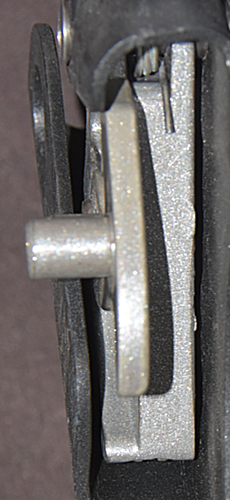
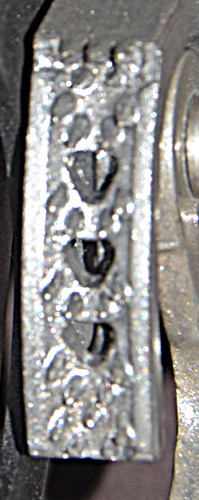 Technical Details
Technical Details
I acquired my Krok, Version I 36011_45.5 from Krok in 2021.
The Krok, Version I 36011_45.5 is 190 mm. tall, 93 mm. wide, 31 mm. thick, and weighs 284 g. The rope channel is 16 mm. wide. The pivot is centered 47 mm. from the inside of the rope channel. The cam radius increases from 37 to 58 mm. over an angle of 42°, giving a 31° cam angle. The tooth pattern is (3.2.2)(1H1.2)^3(2.3.2).
Version I has an alloy steel. The reflex trigger is integrated into the cam safety rather than being a separate piece.
The front of the rope channel is printed with "WLL 4kN," a hollow up-pointing arrow with "Max 300 кг" inside,"MBS 20kN," the Krok logo, "1901.2154," and a book-with-an-"i" icon.
The reflex trigger on Version I is slightly larger and straighter than the one on Version H, and it fits my hands better. Since it is built into the cam safety, it cannot be removed without cutting metal, but if I wanted a reflex trigger, I would prefer this design to the one on Version I.
[ Top
| Version A
| Version B
| Version C
| Version D
| Version E
| Version F
| Version G
| Version H
| Version I
| Friendship-2
| Return to H.E.C. Ascenders
]
Version J with Elevon + Roller
(Блок-ролик "Элевон +" с Жумаром)
(3201_1140.149 RH)
(#3401)
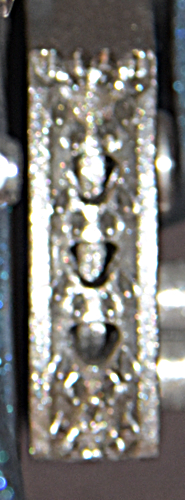 Technical Details
Technical Details
I acquired my Krok Version J with the Elevon + Roller from Krok in 2021.
Version J with the Elevon + roller attached is 191 mm. tall, 99 mm. wide, 37 mm. thick, and weighs 304 g. The rope channel is 16 mm. wide. The pivot is centered 47 mm. from the inside of the rope channel. The cam radius increases from 37 to 58 mm. over an angle of 42°, giving a 31° cam angle. The tooth pattern is (3.2.2)(1H1.2)^3(2.3.2).
The Elevon + (Элевон +) is a pulley assembly attached to the back of the ascender front strap with two 3 mm. machine screws and nylon lock nuts. The pulley shell is stamped from 2 mm. aluminum-magnesium alloy and then painted with the same textured paint used on the ascender body. The pulley is 12.8 mm. wide with a 28.4 mm. outer diameter. There is a 10.3 mm. wide U-shaped groove giving the pulley an inner diameter of 22 mm.
A spring clip mounted on two pins helps keep the sling from coming off the pulley.
The front of the rope channel is printed with "WLL 4kN," a hollow up-pointing arrow with "Max 300 кг" inside,"MBS 20kN," the Krok logo, "1901.1894," and a book-with-an-"i" icon. The Elevon is printed with the Krok logo, "Элевон +," "WLL 2,5 kN," "MBS 4 kN," a book-with-an-"i" icon, and "1901.3014."
The Version J ascender proper is the aluminum-magnesium alloy frame equivalent of Version F. The Elevon + could be attached to similar Krok ascender versions on this page (left- or right-handed) by simply drilling the necessary holes and bolting it in place.
The Elevon + copies an old idea that originally was born and subsequently died with the Petzl Pompe, only to be reincarnated as the Climbing Technology Quick Roll. The idea should have remained dead, because it applies a bandage to the overweight caver problem instead of addressing the root cause. Empty the junk from your
cave pack or go on a diet instead, but get rid of the weight you are hauling and you won't need
this idea.
[ Top
| Version A
| Version B
| Version C
| Version D
| Version E
| Version F
| Version G
| Version H
| Version I
| J /w Roller
| Return to H.E.C. Ascenders
]
Friendship-2
(Дружба-2)
(3601_2651.57)
(#3402)
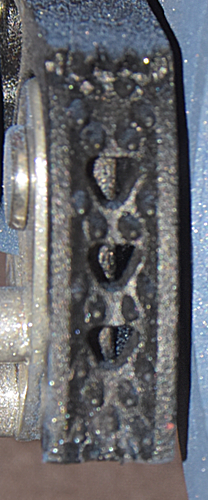 Technical Details
Technical Details
I acquired my Krok, Version I 36011_45.5 from Krok in 2021.
The Friendship-2 is 189 mm. tall, 157 mm. wide, 33 mm. thick, and weighs 331 g. The rope channel is 15 mm. wide. The pivot is centered 47 mm. from the inside of the rope channel. The cam radius increases from 37 to 58 mm. over an angle of 42°, giving a 31° cam angle. The tooth pattern is (3.2.2)(1H1.2)^3(2.3.2).
My Friendship-2 consists of a Version E ascender with a stamped auxiliary handle riveted to the right side. The auxiliary handle has shallow reinforcing rib stamped into the top and extending behind the main ascender front strap.
The front of the rope channel is printed with "WLL 4kN," a hollow up-pointing arrow with "Max 300 кг" inside,"MBS 20kN," the Krok logo, "1901.2154," and a book-with-an-"i" icon.
The Friendship-2 is a single-rope ascender. Two-handled ascenders are popular among the arborists, who often prefer double-rope ascenders for their double-rope climbing. I'm not a Tarzan, so it would not be right
for me to discuss their techniques or evaluate equipment for their applications.
I don't see the Kong Twin being used by
mainstream cavers or climbers. Caver systems do not normally rely on two-arm strength, and so we don't normally need the double handle of the Friendship-3. Climber systems usually use two ascenders with one hand operating each, and in that case, the second handle is not necessary.
[ Top
| Version A
| Version B
| Version C
| Version D
| Version E
| Version F
| Version G
| Version H
| Version I
| J /w Roller
| Friendship-2
]




